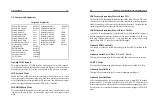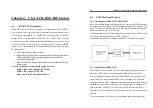
User’s Manual
23
2-4. Installing Memory
The motherboard offers two 168pin DIMM sockets supporting up to 1GB of
memory. The DIMM memory can be 66MHz, 100MHz (PC-100) or 133 MHz
(PC-133).
2-5. Shared VGA Memory
The ENDAT-3702 / ENDAT-3902 is using built-in AGP VGA controller with share
memory architecture (SMA) -
AGP mode with 2MB to 32MB
of system memory.
The ENDAT-3701 motherboard has 2MB build-in dedicate memory for VGA chip
C&T 69000, and 4MB build-in dedicated memory for chip C&T 69030. The
amount of video memory on motherboard determines the number of colors and the
video graphic resolution.
2-6. Installing Riser Card
Installing Riser Card (Max. 3 PCI Slot on Riser Card)
PCI Slot
INT
ADSEL
PCI 1
A,B,C,D AD24(Onboard LAN)
PCI 2
B,C,D,A
AD23
PCI 3
C,D,A,B
AD22
PCI 4
D,A,B,C
AD21
There are two different riser cards that can be fitted to ENDAT-3701/3702/3902
All-In-One motherboard. The first one is a 98pin ISA only Bus riser card
(traditional ISA Bus riser card), the second one is a 188pins PCI/ISA riser card.
Please note: PCI/ISA riser cards jumper settings have to be matched
with the motherboard INT/AD-select jumper.
The default INT/AD-select
for ENDAT-3701/3702/3902 All-In-One motherboard is listed in the above table.
However, it could be revised by changing
JP23
setting for different INT/AD-select.
The following table shows the JP23 configurations:
24
The ENDAT-3701/3702/3902 All-In-One motherboard
JP23 Configurations:
Expansion for PCI Slot
* JP23 = 1-2
JP23 = 2-3
Expansion PCI 1
INT =A,B,C,D
INT = B,C,D,A
Expansion PCI 2
INT = B,C,D,A
INT = C,D,A,B
Expansion PCI 3
INT = C,D,A,B
INT = D,A,B,C
Expansion PCI 4
INT = D,A,B,C
INT = A,B,C,D
Note: Even change the JP23 setting for different configuration the AD-select should
be match to each INT. Please using the default setting as above if you are not
familiar with the configuration of raiser card and add-on card .
Caution:
Do not insert PCI Bus Add-On cards directly into the on-board
expansion slot!
2-7. Assigning IRQs for Expansion Cards
Some expansion cards require an IRQ (Interrupt request vector) to operate.
Generally, each IRQ must be exclusively assigned to specific use. In a standard
design, there are 16 IRQ available with 11 of them already in used by other part of
the system.
Both ISA and PCI expansion cards may need to use IRQ. Cards installed in the ISA
Expansion Bus have the first priority to use the available system IRQs. Any
remaining IRQ then, may be assigned to this PCI Bus. Microsoft's Diagnostic
(MSD.EXE) utility included in the Windows directory can be used to see their map.
Make sure that there are no two devices using the same IRQ in the system.
Otherwise this will cause the system to hang up or give unexpected results. To
simplify the process, this motherboard complies with the Plug and Play (PnP)
specifications, which was developed to allow automatic system configuration.
Whenever a PnP-compliant card is added to the system, PnP cards and IRQs are
automatically assigned if available. If the system has both Legacy and PnP ISA
cards installed. IRQs are assigned to PnP cards from those not used by Legacy
cards. The PCI and PnP configuration in the BIOS setup utility can be used to
indicate which IRQs have being used by Legacy cards. For older Legacy cards that
do not work with the BIOS, you can contact your vendor for an ISA configuration
utility.
















































